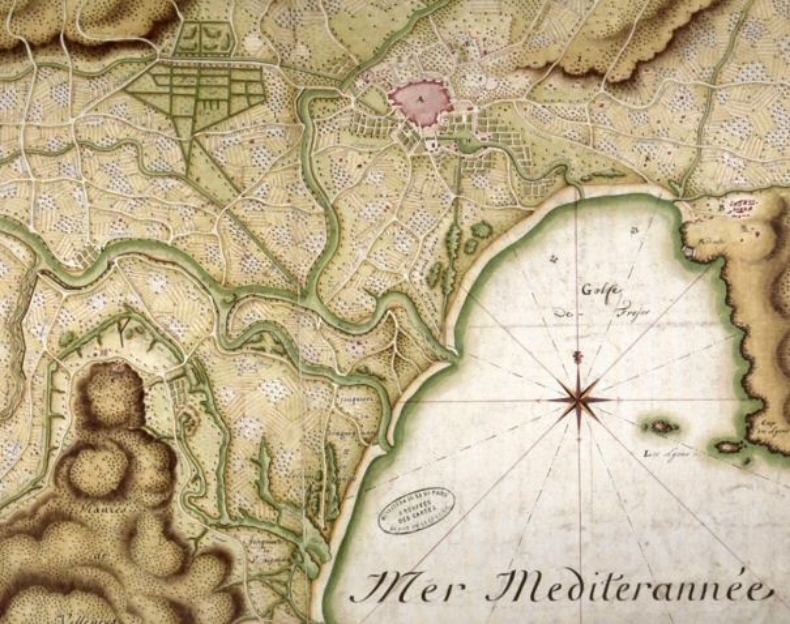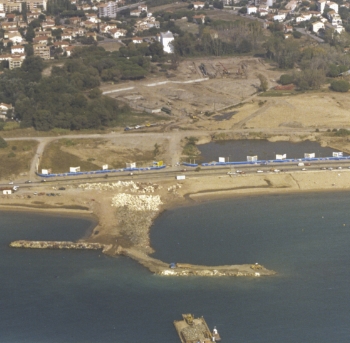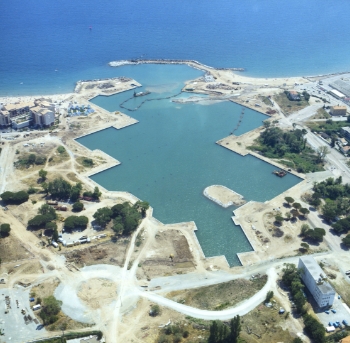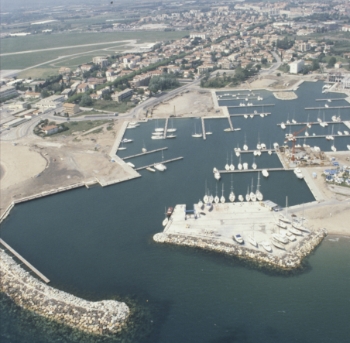Rediscovered
maritime tradition
François Léotard, Fréjus city mayor, opens Port-Fréjus on the 12th July 1989. Thanks to its creation, the town gets its naval vocation back, which is the reason why it did so well through the Roman time.
In creating Port-Fréjus, the local council wants also to convert and make the coastline more beautiful : tourists loves Fréjus-Plage, looking for a family and peaceful seaside resort.
The Port-Fréjus marina brings the sea and the town centre together, thanks to a urban link marked out by cultural and leisure activities, by shops and restaurants.
The marina construction permitted to quickly reach these goals, and to give it its own identity.

Two thousands years ago, the Roman people called Fréjus « Forum Julii ». It is one of the most important Mediterranean harbours : bigger, more animated, more full of life than Marseille (Massilia). Fréjus fights the devastating time effects : during the Middle Ages, Fréjus picks up again after getting stuck in the sand and keeps prospering thanks to the trade.
The ancient harbour kept the ruins of its hours of glory : they are still proudly up in the town.

For more than ten years, a team of passionated men and women are working relentlessly to build Port-Fréjus. The inauguration rewards them for their efforts, and the results are stunning : a 7,2 hectares surface area, a opening 65 meters large, a breakwater 220 meters long…
Today, Port-Fréjus has 849 mooring rings for ships of 40 meters maximum : it is still one of the principal marinas on the Mediterranean coastline.
Even the marina conception makes it different of the others : Port-Frejus is not only a beautiful marina, but a real neighbourhood thanks to its three thousands houses, shops and its own events.





Photos from the construction of the Port Fréjus basin (the 3rd photo was taken in September 1990).
Photo credits (3 photos): Robin Hacquard (official photographer for Fréjus town)
Port Fréjus II
the canal
In order to build this extension, the town of Fréjus worked with experts (jurists, technicians, chartered accountants, urban planners and architects). The neighbourhood is organized around a navigable channel, dug in the bell tower of the town centre axis. Modern buildings are running alongside the quays, which are set up for pedestrians. The promenade is quiet, far from the principal marina excitement.
The project in figures : 33 000 m² of habitations and 7000 m² of public equipment.


The
ANCIENT HARBOUR
The ancient harbour is an artificial basin dug in the swamps alongside the rocky spur on which is built the town of Fréjus. So it is located inland, 1200 meters from the sea.
We can follow the canal to the sea thanks to a crenelated wall on the West side. The basin is a irregular polygon around 17 hectares, limited on the South side by a 560 meters long parapet.
The harbour entry is distinguishable by a construction known as the « August’s Light », still visible today.
History noteworthy event : in 31 BC, the ancient Fréjus harbour welcomed the Roman emperor Octave-Auguste’s war ships, taken from the military general Marc-Antoine, Queen Cleopatra ally and lover, during the famous Actium battle. That story shows how important was the Fréjus harbour in these times.
On the North-West side of the basin, archeologists found an esplanade leading to an inner harbour thanks to blocks (under the « Porte d’Orée » carpark). This one, nearly intact, was used from the Middle Ages to the XVIIth century. By the way, he was called « the Pool » because its surface area had considerably decreased.
The sea and the land gave Fréjus plenty of ressources. Fishing especially supplyed the « allec » production, a « garum » variety, which was a sort of condiment made of fish flesh.
Since 1886, the ancient Roman harbour ruins are listed as Historical Monuments.
Actually it’s not a door but an arch from monumental thermes (from the IInd century), alongside the ancient harbour.
The « Saint-Antoine » small hill is a rocky spur located to the south of the Roman city : it faces the sea and once overlooked the ancient harbour to the East.
Big houses ruins have been found, built at the emperor Octave-Auguste time. Established on important backfills, these buildings, because of their dimensions, were maybe public and residential buildings,
The walls are made of pink sandstone breeze blocks, typical from the « Forum Julii » constructions.
The Southern and a part of the Eastern quays outline are the only ones still identifiable.
The pathway links the Southern quays to the Saint-Antoine Small Hill and the Auguste’s Light ; from there, we find the wall protecting the access canal to the sea.
This tower, 10 meters high, is still visible today. It is probably a daymark which was informing sailors about the entry of the harbour (a daymark is a fix and identifiable landmark, without any ambiguity, used by sailors. It’s generally a building.)
The Fréjus harbour sheltered for a long time military or coastguard ships (during the Ist and the IInd centuries).
Located next to a shipping road highly frequented, linking Italia, Marseille, Narbonne and Spain, the merchand ships found with the Fréjus harbour a large basin 17 hectares large, split in several wall-protected basins, which were connecting with the sea thanks to a canal.
In 1970, during archeological excavations in a roman house, a two-headed white marble statue of Hermes is discovered, probably from the middle of the Ist century.
Today, it belongs to the Frejus Archeologist Museum. The two-headed Hermes is now the symbol of Fréjus, and inspired the artist who realized the fountain decorating the Hermes Door.




